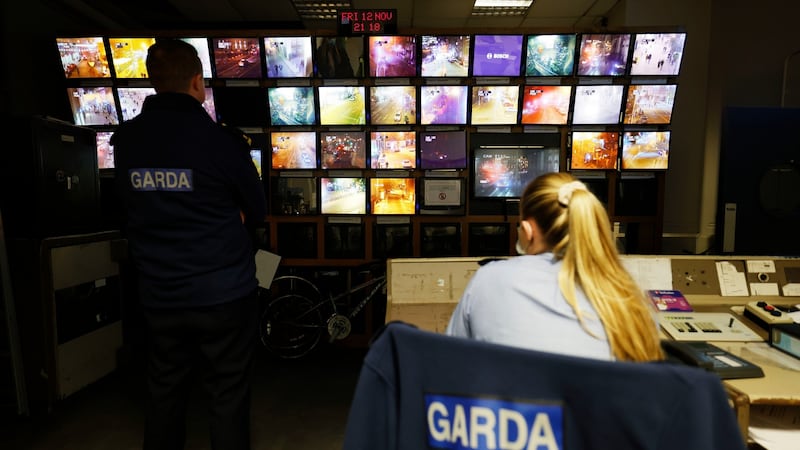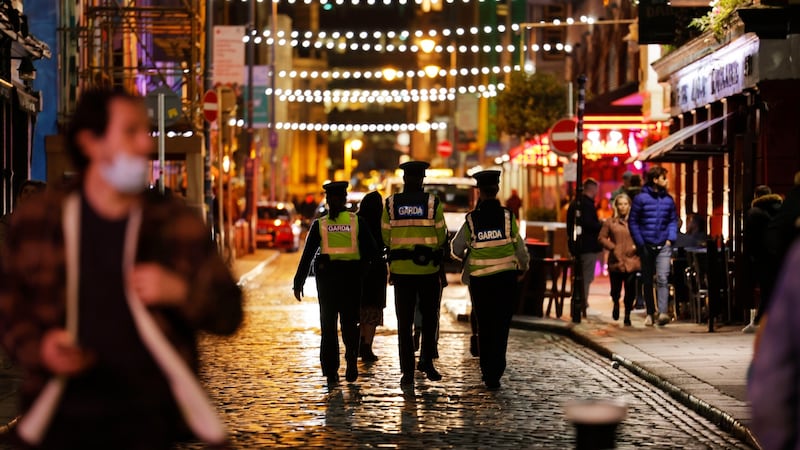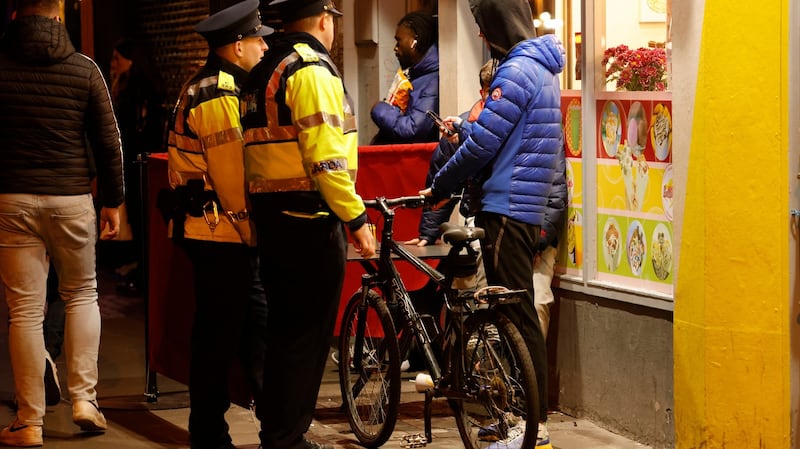Sgt Eoghan Byrne darts out of the patrol car and runs at speed across the street, right into the middle of the melee. It's just after 1am outside Copper Face Jacks on Harcourt Street in Dublin's south inner city and a young reveller has been ejected from the nightclub. It won't be happening for him tonight and he's furious.
He lets fly with shouts and begins lunging back at the security staff. Another man also gets involved as heavy shoves go back and forward. The situation looks like it’s about to explode. Just then, the imposing figure of Sgt Byrne lands on the scene.
He ushers the ejected nightclub patron away from the flashpoint and onto the other side of the street. He urges him to calm himself or face the consequences. But the handcuffs don’t come out. The situation is diffused just before it might have gotten physical, or criminal.
The lowest ebb came when crowds gathered to drink and socialise on South William Street on Friday, June 4th, and were baton charged by members of the Garda's Public Order Unit
Byrne establishes the man is irate because his girlfriend is still in Coppers. The sight of the Garda uniform and Byrne’s firm approach immediately restore order – reinforced by the sudden appearance of the man’s girlfriend from inside the nightclub. The young couple are soon on their way down the street, looking relieved the tension was nipped in the bud.
“He wasn’t a bad young fella, actually he was grand,” says Sgt Byrne, whom The Irish Times has joined, with his team, as part of a night on the policing frontlines of Dublin city centre.
Operation Citizen
Not all of those who have been dealt with by the Garda in recent months have been “grand young fellas”. Indeed, the city centre has witnessed some very ugly scenes during the pandemic, with no shortage of controversy around the Garda’s approach at times.
The lowest ebb came when crowds gathered to drink and socialise on South William Street on Friday, June 4th, and were baton charged by members of the Garda’s Public Order Unit.

Those scenes followed the emergence of a pronounced street drinking culture in the city as pub opening was restricted but "takeaway pints" were permitted. There were also several clashes between anti-lockdown protestors and gardaí on Grafton Street that resulted in baton charges by Garda members this year and last.
“People saw the videos of all of those incidents going around social media and it gave the impression the (city centre) had absolutely gone wild,” one senior officer told The Irish Times.
"Then we had Jack Woolley getting his face sliced open in an attack a few months ago; photographs of him drenched in blood. People see that and they think 'If that can happen to a guy who represented Ireland in taekwondo at the Olympics, Dublin must be gone crazy'. So that's the perception we're facing."
The Garda’s response is Operation Citizen, which began on October 22nd when nightclubs were allowed to reopen. It will run through the festive period and on to year-end. Two new units of eight Garda members each have been created to work new 12-hour shifts specifically for the operation. They work from 4pm to 4am and are deployed specifically to police the boardwalk, a public order and assault hotspot, and its environs.
They are backed by 20 other gardaí on foot or mountain bike patrols as well as 24 personnel in 12 patrol vehicles from Pearse Street, Store Street, Kevin Street and the Bridewell Garda stations. In the event of a major incident there are 10 members of the Regional Armed Unit to call upon as well as 25 Public Order Unit members, the Garda Dog Unit and Garda Mounted Unit.
The idea behind the new 4pm shift start time is for a large number of Garda personnel to take up positions on the streets before crowds begin to flock into places like Temple Bar, Camden St and the boardwalk, among others.
“That’s built on what happened on South William Street and a few other places,” explains Sgt Byrne. “We get in there before anyone who has any intention of causing trouble. Every time anyone comes out of a club, pub, they’re met; we’re there. As I say to our people here; if your ma or da was walking down this street, would you be happy for them to keep going? If not, fix it. End of story.”

From Bray, Co Wicklow, Sgt Byrne (38) worked in Chadwicks builders providers as well as pubs and nightclubs before joining the Garda 14 years ago. He arrived in Store Street two years ago from the Garda National Drugs and Organised Crime Bureau.
He accepts there is a perception the city centre has become very dangerous since the pandemic began. He believes that narrative took hold during lockdown when “the homeless, beggars, drug users or people who are just up to no good” remained on the streets, which were otherwise deserted.
“That was all that people saw because they didn’t get lost in the crowd any more,” he says.
Dublin’s policing border
Usually personnel from Store St and Pearse St stations, police their own patches only, north and south of the River Liffey. That approach has resulted in siloed policing operations. There has been little, if any, mixing of policing goals or Garda personnel. The two stations even operate on separate radio channels. Incredibly, that means frontline personnel from one station cannot directly communicate with their colleagues from the other station while they are all on the streets.
This has changed under Operation Citizen. Units are now a deliberate mix of personnel from both stations for the first time ever. When gardaí are deployed onto the streets their beat takes both sides of the river; gone is the idea of personnel from one station not straying out of their district. In another first, all personnel from the two stations are now on the same radio channel, allowing for seamless communication while on the front line.
On Operation Citizen's new 4pm to 4am shift last Friday into Saturday morning Sgt Byrne managed one of the eight-strong units working in twos and threes on foot patrols. Garda Michael Moore and Garda Leigh Higgins, from Pearse St and Store St respectively, have partnered up for the operation.
They seem to know everyone; from the homeless to the drug users and groups of young teenagers flying about the area
Moore, a 31-year-old from Finglas in north Dublin, previously spent four years in Dublin Fire Brigade. However, when he was in the sauna at the gym and could smell the fires he attended coming from his pores he decided to get out on health grounds. He joined the Garda in 2018. Fellow Dubliner Higgins (28) secured a master's degree in hospitality management before embarking on a career in hotel management and then deciding to switch to the Garda force in 2019.
The high volume of their interactions with people is striking. They seem to know everyone; from the homeless to the drug users and groups of young teenagers flying about the area.
They check in with security personnel on the doors of nightclubs – “a mine of information” – to assess activity in the area and speak with pub and club managers for the same reason. Shop owners, including foreign nationals often a “soft touch” for theft and anti social behaviour, are also visited.
They quiz one teenager on suspicion he is selling a stolen bike, catch another with a small amount of drugs. They dart down lanes in Temple Bar to move on people who are drinking or causing disruption and question those suspected of selling drugs. They repeatedly visit the boardwalk and cover huge distances on foot all over the centre of Dublin to make sure they are seen.
“We have a saying here ‘shoulder to the wheel’,” Garda Moore says of Pearse St. “Pre-Covid, it was just that mental. The majority of our calls were assaults. You might be dealing with people who had a lot of drink on board. You’d also have a lot of thefts... pick-pocketers around. I was taken aback a bit at the start; the pace of it. I just said to myself ‘tighten the boots and get in there’.”

Then Covid hit “and the place died a death” as “95 per cent” of the crimes usually associated with the night time economy and excess drinking “disappeared” though crime was now “creeping back up”. However, both Garda Moore and Garda Higgins say the narrative suggesting central Dublin was more dangerous during the pandemic, and remains a more violent place, was out of step with reality.
In the Store Street area, Garda Higgins hit the streets new to the force in December, 2019. He notes the city was now clearly starting to become more vibrant again, though footfall had not yet fully recovered.
“I think for some people there is a sense of cabin fever with Covid – so they were coming out to start socialising again and a lot of people have money to spend,” he said. Garda Higgins added Operation Citizen was about creating an environment to “make sure people can enjoy themselves” rather than being repressive in nature.
Crime down but rebounding
Earlier this year Sinn Féin's justice spokesman Martin Kenny TD asked "how out of touch can someone be?" when Labour Party Dublin Lord Mayor Alison Gilliland pointed to reports that crime was falling in Dublin rather than rising.
However, every piece of data available for the period suggests a lower crime rate in the capital, including the city centre. Last year, for example, the number of assaults recorded by gardaí in Pearse St Garda station – which polices Temple Bar and the vast majority of Dublin’s social scene – dropped by 44 per cent, compared to 13 per cent nationally. The trend has continued in the first 10 months of this year, including the city centre divisions, according to the latest data.
While the crime data does not support the assumption Dublin has become more dangerous, she accepts that is the perception
In the first 10 months of this year in the DMR north central division, crime trends show minor assaults are down four per cent; assault causing harm are down two per cent; public order down by 20 per cent; drug possession for personal use down 36 per cent; drug dealing down 11 per cent; robbery from the person down 20 per cent.
In DMR south central, which includes Pearse St Garda station: minor assaults are down 18 per cent; assault causing harm down one per cent; public order down by three per cent; drug possession for personal use down 34 per cent; drug dealing down 34 per cent; robbery from the person down two per cent.
However, Garda sources caution while the crime rates are down in Dublin, normal service was gradually resuming with “some crazy nights again recently”.
Assistant Commissioner Anne Marie Cagney has said while the crime data does not support the assumption Dublin has become more dangerous, she accepts that is the perception.
“People had a sense that they felt unsafe around the city,” Ms Cagney said, adding Operation Citizen was aimed at increasing the perception of safety.

It is, in essence, a policing approach to tackle the fear of crime as much as crime itself. With that in mind, gardaí patrolling the city streets are being asked to take photos of themselves, preferably with members of the public, for sharing on the Garda’s social media channels. The idea is to use social media to amplify the high visibility on the streets, combating the negative imagery of recent months.
Control room
Eimear Hoban was studying to become a teacher when she changed her mind; giving up that course in favour of a career in the Garda. She started in Pearse St exactly two years ago. Tonight the 22-year-old from Drumcondra, Dublin, is presiding over the "control room" in the station; monitoring live footage from the 33 cameras dotted across the south-central division.
She is in two-way communication with her colleagues on foot and patrolling in vehicles across the division, dispatching them to the scenes of incidents.
“Coming into the job I knew city centre policing was going to be busy but I wasn’t expecting it to be as busy as it is in Dublin 2,” she says of the three-month period of normal policing she experienced pre-pandemic.
“But coming out of Covid and lockdown, the incidents are gradually starting to come back now again. You can have assaults, public order incidents, thefts and a few robberies after midnight and the bar fights at closing time.”
Her colleague Garda Maria Harmon, a 35-year-old from Dublin based across the river in Store Street, says in her near 14 years based there she has never seen the type of co-operation now in evidence Operation Citizen, citing the new shared radio channel and the mixed patrols involving staff from both Pearse Street and Store Street stations.
“It makes perfect sense because, with the bridges, our criminals run from the north side to the south side. We have to switch radio channels and try to get (gardaí) to go onto Pearse St’s channel to stop ‘the guy in the black tracksuit’ who’s running across Grattan Bridge into Temple Bar. There’s a massive delay and it’s too hard to apprehend that person.”
While Operation Citizen is pro-arrest, Garda Harmon says it is not a “zero tolerance approach”. A more nuanced policing style could often diffuse a potentially violent incident before it erupted, negating the need to make arrests, she says.
"I think that's an approach native to Irish people; a good way of talking and calming things before they escalate," she explains. "Irish policing is very different to a lot of places in mainland Europe, where policing can be very militarised. Yes, we have armed support units, public order units that we can call on. But our normal day-to-day policing is more friendly, though it's assertive when needed."
She insists no area of the city was a no-go area, and dismissed the notion some gardaí were afraid to patrol the boardwalk.
“That really annoys me. There is nobody I work with that’s afraid to go anywhere. There are no no-go areas for the guards. Everywhere is policed. But there’ll never be enough guards and crime increases all the time. You could have 1,000 guards working and you’ll never have enough.”










